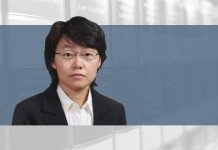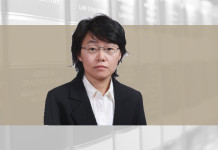One evening in May, the author was contemplating Chang’an Ave from his Beijing office, whereupon his thoughts drifted to the unforgettable case of Shanghai Lian Hua Fibre Corporation’s (LH Fibre) restructuring and acquisition in 2013. The long series of conflicts between business moguls, the early morning strolls along the banks of the Huangpu discussing solutions – all came back with clarity. Three tactical phases were adopted in the course of LH Fibre’s restructuring that assured its success.
Corporate timeline
In October 1984, the shareholders – Shanghai Textile Industry Bureau Operating Company, China International Trust and Investment Corporation, and Shanghai Investment and Trust Corporation – established Shanghai Lian Hua Fibre Co with a registered capital of US$9.6 million.

Senior Partner
Zhong Yin Law Firm
On 30 April 1992, it converted into Shanghai Lian Hua Fibre Corporation, one of the first Sino-foreign equity joint ventures in Shanghai, and it became involved in the pilot project for conversions into joint stock limited companies.
In June 1992, the company was incorporated as Shanghai Lian Hua Fibre Corporation with the approval of the Shanghai branch of the People’s Bank of China, and offered A-shares worth RMB 7,288,600.
In September 1993, LH Fibre announced an offering of 30 million B-shares, as well as its A-shares code, 600617, and B-shares code, 900913.
In November 2001, Shanghai Textile and Shanghai International Group executed an equity transfer agreement, transferring 17.10% of the company’s total share capital to Shanghai International Group; Shangtou Investment also transferred 9,519,480 shares to Shanghai International Group.
On 20 May 2012, Jiangsu Construction and Zhejiang Ruiyi transferred 100% of the equity of Jiangsu Jianfeng by agreement to Zhao Zhiqiang and Zhang Ping, making them the majority shareholders in LH Fibre.
On 23 July 2013, Gao Fengkun and Ren Likun acquired 17,918,110 shares from Zhao Zhiqiang and Zhang Ping by agreement, becoming the majority shareholders in LH Fibre.
On 20 December 2013, LH Fibre offered shares to purchase 100% of the equity of Shanxi Natural Gas. LH Fibre’s main business would be operated by Shanxi Natural Gas, and its name would change to “Guoxin Energy”.
Restructuring strategy
The Shanghai Stock Exchange published a warning of a delisting risk by LH Fibre on 3 May 2013. Its A-share abbreviation was changed from “ST Lian Hua” to “*ST Lian Hua” and its B-share abbreviation to “*ST Lian Hua B”. If LH Fibre’s year-end net assets remained in the red in 2013, there would be a risk that its listing would be suspended or terminated.
Enter the first phase of the plan: compelling Zhao Zhiqiang and Zhang Ping, who lacked assets to inject as majority shareholders, to find an asset restructuring party with strong profitability in order to avoid the delisting of LH Fibre. The formidable Huitai Group in Shandong were contacted, and they acquired Zhao Zhiqiang’s and Zhang Ping’s shares at a premium. Shandong Huitai Group’s profitability additionally ensured that LH Fibre would not be compelled to delist in 2013.
By combing through a vast quantity of LH Fibre’s past documentation, the underlying reasons for the string of unsuccessful restructurings by its major controllers Jiangsu Construction, Zhejiang Wanshili and Gansu Shengda were uncovered. A three-pronged restructuring strategy was prepared to procure or prevent the entry of other forces: (1) controlling the seats on the board of directors, including those of the independent directors; (2) endeavouring to procure a consensus on the restructuring matters with the second largest shareholder and other connected parties so as to carry out a vote on the restructuring at a shareholders’ meeting at the crucial time; and (3) communicating with the China Securities Regulatory Commission’s (CSRC) restructuring review office during the middle and later phases of the restructuring.
The shareholding structure of LH Fibre was found to be quite dubious based on investigations by managers of former majority shareholder Gansu Shengda, with one of the shareholders being a company mysteriously hiding behind a veil, unknown to the outside world. All that was known was that some of the company’s shareholders were blacklisted by the CSRC and that they controlled the board of directors by illicit means. A request was made to the Shanghai securities regulator’s audit team to coordinate work. Before this material asset restructuring, the company’s original main business had essentially ground to a halt.
Enter the second phase of the plan: Assisting Shandong Huitai to secure LH Fibre’s management rights from the former management. They retained LH Fibre’s diligent board secretary and recruited senior officers of Shandong Linuo as advisers to the asset party. This was the first step on the choppy path to restructuring. On 31 March 2013, LH Fibre held a board meeting during which it elected the Huitai Group’s Kong Lingquan as chairman, Li Baorong as vice chairman and Wang Huilan as CFO.
Finally, the third phase of the plan: Aiding LH Fibre and the asset party, Shandong Huitai, in maximizing their benefits. On 30 May 2013, a bitter clash erupted due to a dispute between the restructuring party and the other shareholders over the expected price of the stocks. One of the lawyers in the Zhong Yin team stated that “a legal action is a missile in a restructuring battle, buying time and initiative in an uncertain struggle”. He argued that the team could use the other parties’ error in not having provided sufficient time to convene a board meeting as cause to take legal action in Huangpu District People’s Court over neglect of procedure for calling the board meeting, so as to lock up their restructuring time and reporting procedure.
After complex negotiations and arguments over the details that reached scorched earth intensity, LH Fibre’s and Shandong Huitai’s benefits were maximized – those reaped by Shandong Huitai, the asset party, were particularly fruitful. An action for a revocation of the resolutions adopted on 2 June 2013 at the fourth meeting of the seventh board was filed with the Huangpu District People’s Court on 9 August 2013. With this, all obstacles in the way of the restructuring were swept aside, allowing the restructuring of LH Fibre to be completed in December 2013.
Sun Jian is a senior partner of Zhong Yin Law Firm
31 Floor, Jianwai SOHO A
Dongsanhuan Zhonglu 39, Chaoyang District
Beijing 100022, China
Tel: 86 10 5869 8899
Fax: 86 10 5869 9666
E-mail: sunjian@zhongyinlawyer.com
www.zhongyinlawyer.com






















